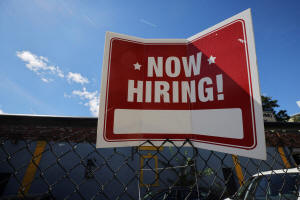Slower, but still strong U.S. job growth expected in August
 Send a link to a friend
Send a link to a friend
 [September 02, 2022] By
Lucia Mutikani [September 02, 2022] By
Lucia Mutikani
WASHINGTON (Reuters) - U.S. employers
likely continued to hire workers at a strong clip in August while
steadily raising wages, signs of persistent labor market strength that
could encourage the Federal Reserve to deliver a third 75 basis point
interest rate hike this month.
The Labor Department's closely watched employment report on Friday would
come a week after Fed Chair Jerome Powell warned Americans of a painful
period of slow economic growth and possibly rising unemployment as the
U.S. central bank aggressively tightens monetary policy to quell
inflation.
The anticipated solid job growth last month would be further evidence
the economy continues to expand even as gross domestic product
contracted in the first half of the year. It is also a sign the Fed
still needs to cool the labor market despite the front loading of rate
hikes.
"If we're still talking about job growth of 300,000, and an unemployment
rate of around three-and-a-half, or 3.6%, I think the Fed really thinks
that the labor market can absorb more aggressive tightening," said Will
Compernolle, a senior economist at FHN Financial in New York. "We're
pretty far from any pain as far as the labor market is concerned."

Nonfarm payrolls likely increased by 300,000 jobs last month after
surging 528,000 in July, according to a Reuters survey of economists.
That would mark the 20th straight month of job growth. While that would
be the smallest increase in 16 months, it would still be way above the
pre-pandemic average.
Estimates for payrolls growth ranged from as low as 75,000 to as high
450,000. The unemployment rate was forecast unchanged at a pre-pandemic
low of 3.5%.
Despite the uncertain economic outlook, demand for labor remains strong.
There were 11.2 million job openings on the last day of July, with two
job openings for every unemployed person.
First-time applications for unemployment benefits remain low and the
Institute for Supply Management's measure of factory employment
rebounded in August after three straight monthly declines. Comments from
factories surveyed by ISM showed they "continued to hire at strong rates
in August, with few indications of layoffs, hiring freezes or head-count
reductions through attrition."
WORKER HOARDING
But the response rate to the Labor Department's establishment survey,
from which the nonfarm payrolls count is derived, has historically
tended to be low in August, resulting in initial job gains arriving
below expectations.
"Over the past five years the average upward revision between the first
and third estimates is nearly 120,000," said Ryan Sweet, a senior
economist at Moody's Analytics in West Chester, Pennsylvania.
"Another factor is that July job growth got juiced by an additional week
between payroll reference periods. Therefore, some hiring that would
normally have occurred in late July or early August may have been pulled
forward."
[to top of second column] |

A "now hiring" sign is displayed outside
Taylor Party and Equipment Rentals in Somerville, Massachusetts,
U.S., September 1, 2022. REUTERS/Brian Snyder

The government surveys businesses for payrolls during the week that includes the
12th of the month. The Fed has twice raised its policy rate by three-quarters of
a percentage point, in June and July. Since March, it has lifted that rate from
near zero to its current range of 2.25% to 2.50%.
Financial markets are pricing a roughly 78% probability of a 75 basis point
increase at the Fed's Sept. 20-21 policy meeting. August consumer price data due
mid-month will also be a major factor in determining the next rate increase.
The labor market has continued to charge ahead, with economists attributing the
resilience to businesses hoarding workers after experiencing difficulties in the
past year as the pandemic forced some people out of the workforce in part
because of prolonged illness caused by the disease.
There is also pent-up demand for workers in service industries like restaurants
and airlines. The labor force participation rate, or the proportion of
working-age Americans who have a job or are looking for one, remains 1.3
percentage points below its pre-pandemic level.
Other economists said while layoffs by major companies were getting media
attention, small companies were hiring. They also argued strong hiring in the
services sector, which was hugely affected by the pandemic, was needed to fight
inflation.
"We're still catching up and this is where I am completely a contrarian," said
Brian Bethune, an economics professor at Boston College. "The more people that
businesses can hire, the more services they can provide, which means more
production and that will reduce inflation. That's what is critical now."
Falling commodity prices have slowed the pace of inflation, with the annual
consumer price index rising 8.5% in August. But rising wages are likely to keep
inflation elevated for a while.
Average hourly earnings are forecast rising 0.4% after a solid 0.5% increase in
July. That would lift the annual increase in wages to 5.3% from 5.2% in July.
Strong wage gains are keeping the income side of the economic growth ledger
expanding, though at a moderate pace, and a recession at bay for now.

"If there is a recession, it's going to be mild," said Christopher Kayes, a
professor of management at the George Washington University School of Business
in Washington. "It will be a recession with almost full employment. We haven't
seen that in our lifetime."
(Reporting by Lucia Mutikani; Editing by Josie Kao and Andrea Ricci)
[© 2022 Thomson Reuters. All rights
reserved.]This material may not be published,
broadcast, rewritten or redistributed.
Thompson Reuters is solely responsible for this content. |